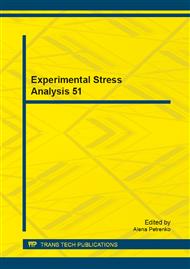[1]
G. Baronio, L. Binda and L. Lombardini, The role of brick pebbles and dust in conglomerates based on hydrated lime and crushed bricks, Construction and Building Materials 11 (1997) 33–40.
DOI: 10.1016/s0950-0618(96)00031-1
Google Scholar
[2]
H. Böke, S. Akkurt, B. Ípekoğlu and E. Uğurlu, Characteristics of brick used as aggregate in historic brick-lime mortars and plasters, Cement and Concrete Research 36 (2006) 1115–1122.
DOI: 10.1016/j.cemconres.2006.03.011
Google Scholar
[3]
V. Nežerka and J. Zeman, A micromechanics-based model for stiffness and strength estima-tion of cocciopesto mortars, Acta Polytechnica 52 (2012) 29–37.
DOI: 10.14311/1672
Google Scholar
[4]
B. Patzák and Z. Bittnar, Design of object oriented finite element code, Advances in Engineering Software 32 (2001) 759–767.
DOI: 10.1016/s0965-9978(01)00027-8
Google Scholar
[5]
M. Jirásek, Non-local damage mechanics with application to concrete, Revue Europeanne de Génie Civil 8 (2004) 683–707.
DOI: 10.1080/12795119.2004.9692625
Google Scholar
[6]
T. Mori and K. Tanaka, Average stress in matrix and average elastic energy of materials with mixfitting inclusions, Acta Metallurgica 21 (1973) 571–574.
DOI: 10.1016/0001-6160(73)90064-3
Google Scholar
[7]
Y. Benveniste, A new approach to the application of Mori-Tanaka theory in composite materials, Mechanics of Materials 6 (1987) 147–157.
DOI: 10.1016/0167-6636(87)90005-6
Google Scholar
[8]
J. Vorel, V. Šmilauer, Z. Bittnar, Multiscale simulations of concrete mechanical tests, Journal of Computational and Applied Mathematics 236 (2012) 4882–4892.
DOI: 10.1016/j.cam.2012.01.009
Google Scholar
[9]
W. Sharpe Jr., J. Pulskamp, D. Gianola, C. Eberl, R. Polcawich and R. Thompson, Strain measurements of silicon dioxide microspecimens by digital image processing, Experimental Mechanics 47 (2007) 649–658.
DOI: 10.1007/s11340-006-9010-z
Google Scholar
[10]
V. Nežerka, Z. Slížková, P. Tesárek, T. Plachý, D. Frankeová and V. Petráňová: Compre-hensive Study on Microstructure and Mechanical Properties of Lime-Pozzolan Pastes, Cement and Concrete Research (submitted).
DOI: 10.1016/j.cemconres.2014.06.006
Google Scholar
[11]
M. Kvasnica: Real-time model predictive control via multi-parametric programming: theory and tools, VDM Verlag, Saarbruecken.
Google Scholar
[12]
T. Plachý, P. Padevět and M. Polák: Comparison of Two Experimental Techniques for Determination of Young's Modulus of Concrete Specimens, Proceedings of the 5th WSEAS International Conference on Applied and Theoretical Mechanics - Recent Advances In Applied And Theoretical Mechanics, Athens, WSEAS Press (2009).
Google Scholar
[13]
T. Plachý, P. Tesárek, A. Wilczynska, P. Padevět, Experiment in real conditions: Mechanical properties of gypsum block determined using non-destructive and destructive methods International Conference on Engineering Mechanics, Structures, Engineering Geology, International Conference on Geography and Geology – Proceedings (2010).
Google Scholar
[14]
V. Nežerka, P. Tesárek, T. Plachý, Non-destructive testing of stiffness development in lime-pozzolana mortars, Experimental Methods and Numerical Simulation in Engineering Sciences, Proceedings of XIIIth Bilateral Czech/German Symposium 2012 19–22.
Google Scholar
[15]
P. Tesárek, T. Plachý, P. Ryparová, J. Němeček, Micromechanical properties of different materials on gypsum basis, Chemicke Listy 106 (2012) s547–s548.
Google Scholar
[16]
P. Tesárek, J. Němeček, Microstructural and micromechanical study of gypsum, Chemické Listy 105 (2011) s852–s853.
Google Scholar


